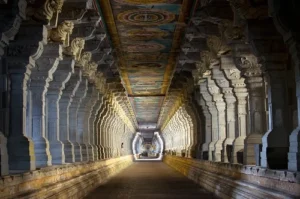Rameshwaram Temple is an Enormous Hindu temple near India’s southernmost point. This world-famous temple is dedicated to Lord Shiva. Additionally, being one among the Char Dhams and 12 Jyotirlinga temples, it has become one of the most sacred places for Hindus.
Rameshwaram, a charming seaside town and well-liked Hindu holy site that draws nature lovers and adventure seekers, gained notoriety from the epic Ramayana.
A veritable sanctuary for the pious is the holy residence of the Hindu god Shri Ram, who is revered and treated with humility. When it comes to the climax of his search for salvation and the sacred sites consecrated by the epic “Ramayana,” no Hindu trip is completed without a pilgrimage to both Varanasi and Rameswaram. After a fourteen-year banishment, the god Ram is said to have visited this country.
It is also said that Lord Rama worshipped Lord Shiva in this location, which helped him win the famous battle described in the Ramayana.
The massive Rameshwaram temple was constructed in the seventeenth century on the ancient spot purported to have been blessed by the footprints of the god Rama during his trip across the island to save his wife, Sita, from the Ravana.
Location:

The Rameshwaram Temple is located in Rameswaram, a town in the South Indian state of Tamil Nadu.
You can easily access the Rameshwaram temple via various public transportation like buses, trains, and planes. The temple is approximately 2 km from Rameswaram Bus Station and 1 km from Rameswaram Railway Station. Madurai, approximately 179 km away from the temple, is the nearest airport to this location.
Construction of Rameshwaram Temple:

Since the 12th century, rulers have started the construction of Rameshwaram or Ramanathaswamy temple. Further, it was built in the 15th century by the Vaishya people of Nagoor and King Udaiyan Sethupati. Tirumalaya Sethupathi partitioned the second section of the southern part of the temple in the 16th century. At the entrance of the temple are statues representing Tirumalaya and his son.
The current layout of the Rameshwaram Temple is thought to have been constructed in the 17th century. Experts claim that King Kizhavan Sethupathi gave the order to build the temple. The construction of the temple also greatly benefited from the contributions of Jaffna Raja of the Sethupathi Kingdom.
The Story of Rameshwaram Temple
Architectural Details of Rameshwaram Temple:

Renowned for its striking Hindu architecture, the Rameshwaram Temple is distinguished by its expansive temple complex, beautiful sculptures, and tall gopurams (ornate entry towers). Over the ages, the temple’s structure has changed, adding to its splendor under many dynasties and kings.
The temple complex’s most well-known and impressive building is the main entryway, known as the East Gopuram. With elaborate carvings and sculptures of numerous deities and celestial beings, it is embellished to a height of 126 feet. The temple’s additional gopurams are similarly magnificent and provide guests with a visual feast.
Agni Theertham, the temple’s sacred tank, is another noteworthy aspect. The sacred waters of this tank are thought to be able to forgive sins, according to devotees. Several shrines honoring other deities, such as Lord Shiva and Lord Rama, are also located within the temple.
Using granite and limestone, the Dravidian-style Ramanathaswamy Temple was constructed. The Rameshwaram Temple is shielded from all sides by a tall wall or mail, as is the case with other South Indian temples. The wall measures 675 feet long from north to south and 85 feet long from east to west.
The vast colonies are separated by lengthy corridors at this Rameshwaram temple. One of the main inner corridors of the temple is situated on a platform five feet high. The second is made up of a roof, sandstone columns, and beams. To the west lies the Sethumadhav temple, reached by the world’s largest corridor, the third one. Its length is roughly 197 meters.
The lingams:
The Rameshwaram Temple’s enormous fame is a result of the many stories surrounding it and the lingams’ placement. The stories may be numerous, but they all point to Lord Vishnu’s incarnation as the person who placed the idols.
Notably, the holy temple houses two Shiva lingams – the Ramalingam and the Vishwalingam. Legends suggest that the first one was constructed by Devi Sita, and the other one was carried by Lord Hanuman from the Great Kailash. Worshiping the Vishwalingam first and the Ramalingam second has long been customary, and it still is.

Before approaching the two lingams, people give penance and cleanse their sins in the temple’s 22 sacred kunds by taking holy dips. You may sense the presence of the Lord in the air on the holy island, believe it or not. The purity and tranquillity you experience here are exquisite, and Rameshwaram is the only place that even remotely resembles a god. You have to see it to believe it.
Spiritual Services offered at Rameshwaram Temple:
The Ramanathaswamy Temple in Rameshwaram provides a diverse range of services for its devotees. Following is a list of a few of them:
Darshan:
The temple allows followers to see Lord Ramanathaswamy, the principal deity of the temple. Entering the temple, devotees can see the holy statue up close, offer prayers, and seek blessings.
Darshan of the Rameshwaram Rama Lingam:
The Rameshwaram Rama Lingam is very important since it is thought to have been dedicated by Lord Rama. This rare and highly regarded lingam always welcomes the devotees to give darshan.
Poojas and Jal Abhishekams:
The temple offers a variety of ceremonial bathings, or abhishekams, and ritualistic worship services for Lord Ramanathaswamy and other deities. By hiring priests to carry out the rituals on their behalf, devotees can take part in these rites and give their prayers.
Teertham:
The temple’s grounds contain several teerthams, or sacred tanks. Before approaching the main temple, devotees can bathe in these teerthams, such as Agni Theertham. It is said that taking a bath in these sacred waters can purify the soul and grant spiritual purity.
Annadanam:

Offering food to devotees is a religious activity that is carried out at the Rameshwaram Temple. Prasad, or heavenly offering, is a hearty vegetarian meal that devotees can receive by participating in the temple’s free food distribution program.
Temple Aarti:
The many aarti rites held by the Ramanathaswamy Temple at Rameshwaram throughout the day provide a spiritually uplifting environment for devotees. Offering light to the gods during aarti is a ceremony that is accompanied by prayers and devotional songs.
Best Time to Visit Temple:
The months from September, October to March are the best times to visit Rameshwaram because of the pleasant temperature throughout this time.
In Rameshwaram, the winter season, which runs from November to February, is regarded as the busiest travel time. These months provide nice, generally cooler weather, which makes them perfect for outdoor activities and trips to temples.
However, the temple witnesses a large number of followers during Maha Shivratri. In that time, people of all faiths come here to honor Lord Shiva, make offerings to him, and get his blessings.
Conclusion:
Hindus still consider the Rameshwaram Temple to be one of the most significant pilgrimage sites because of its magnificent architecture, religious significance, and long history. Due to its connections to the epic Ramayana, Lord Rama, and the legendary Sethu Samudram, it has great spiritual and cultural significance also.
The Tamil Nadu government’s Hindu Religious and Charitable Endowments Department is responsible for the temple’s upkeep and management. Additionally, the authorities at the temple want to expand and refurbish the routes leading to the 22 sacred theerthams.
Moreover, the stands as a timeless symbol of devotion and cultural heritage in India, drawing pilgrims and tourists from all over the world with continuous repair work and enhanced facilities.

